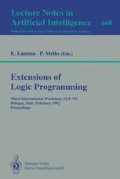Abstract
LIFE is an experimental programming language proposing to integrate logic programming, functional programming, and object-oriented programming. It replaces first-order terms with ψ-terms, data structures which allow computing with partial information. These arc approximation structures denoting sets of values. LIFE further enriches the expressiveness of ψ-terms with functional dependency constraints. Whereas LIFE's relations defined as Horn-clauses use ψ-term unification for parameter-passing, LFFE's functions use ψ-term matching (i.e., one-way unification). We explain the meaning and use of functions in LIFE declaralively as solving partial information constraints. These constraints do not attempt to generate their solutions but behave as demons filtering out anything else. In this manner, LIFE functions act as declarative coroutines.
Preview
Unable to display preview. Download preview PDF.
References
Hassan Aït-Kaci. An algebraic semantics approach to the effective resolution of type equations. Theoretical Computer Science, 45:293–351, 1986.
Hassan Aït-Kaci and Roger Nasr. LOGIN: A logic programming language with built-in inheritance. Journal of Logic Programming, 3:185–2l5, 1986.
Hassan Aït-Kaci and Roger Nasr. Integrating logic and functional programming. Lisp and Symbolic Computation, 2:51–89, 1989.
Hassan Aït-Kaci and Andreas Podełski. Functions as passive constraints in LIFE. PRL Research Report 13, Digital Equipment Corporation, Paris Research Laboratory, Rueil-Malmaison, France, June 1991. Revised, Novembre 1992.
Hassan Aïl-Kaci and Andreas Podelski. Towards a meaning of LIFE. In Jan Maluszyński and Martin Wirsing, editors, Proceedings of the 3rd International Symposium on Programming Language Implementation and Logic Programming (Passau, Germany), pages 255–274. Springer-Verlag, LNCS 528, August 1991.
Hassan Aït-Kaci and Andreas Podelski. Towards a meaning of LIFE. PRL Research Report 11, Digital Equipment Corporation, Paris Research Laboratory, Rueil-Malmaison, France, 1991. (Revised, October 1992; to appear in the Journal of Logic Programming).
Hassan Aït-Kaci, Andreas Podelski, and Gert Smolka. A feature-based constraint system for logic programming with entailment. In Proceedings of the 5th International Conference on Fifth Generation Computer Systems, pages 1012–1022, Tokyo, Japan, June 1992. ICOT.
Rolf Backofen and Gert Smolka. A complete and decidable feature theory. DFKI Research Report RR-30-92, German Research Center for Artificial Intelligence, Saarbrücken, Germany, 1992.
Staffan Bonnier and Jan Maluszyński. Towards a clean amalgamation of logic programs with external procedures. In Robert A. Kowalski and Kenneth A. Bowen, editors, Logic Programming. Proceedings of the 5th International Conference and Symposium, pages 311–326, Cambridge, MA, 1988. MIT Press.
Alain Cołmerauer. Prolog II: Manuel du référence et modèle théorique. Rapport technique. Université de Marseille, Groupe d'Intelligence Artificielle, Faculté des Sciences de Luminy, Marseille, France, March 1982.
Seif Haridi and Sverker Janson. Kernel Andorra Prolog and its compulation model. In David H. D. Warren and Peter Szeredi, editors. Logic Programming, Proceedingsof the 7th International Conference, pages 31–46, Cambridge, MA, 1990. MIT Press.
Robert Harper, Robin Milner, and Mads Tofic. The definition of standard ML — Version 2. Report LFCS-88-62, University of Edinburgh, Edinburgh, UK, 1988.
Michael Maher. Logic semantics for a class of committed-choice programs. In Jean-Louis Lassez., editor. Logic Programming, Proceedings of the Fourth International Conference, pages 858–876, Cambridge, MA, 1987. MIT Press.
Lee Naish. MU-Prolog 3.1db Reference Manual. Computer Science Department, University of Melbourne, Melbourne, Australia, May 1984.
Vijay Saraswat. Concurrent constraint programming. In Proceedings of the 7th Annual ACM Symposium on Principles of Programming Languages, pages 232–245. ACM, January 1990.
Author information
Authors and Affiliations
Editor information
Rights and permissions
Copyright information
© 1993 Springer-Verlag Berlin Heidelberg
About this paper
Cite this paper
Aïl-Kaci, H., Podelski, A. (1993). Logic programming with functions over order-sorted feature terms. In: Lamma, E., Mello, P. (eds) Extensions of Logic Programming. ELP 1992. Lecture Notes in Computer Science, vol 660. Springer, Berlin, Heidelberg. https://doi.org/10.1007/3-540-56454-3_6
Download citation
DOI: https://doi.org/10.1007/3-540-56454-3_6
Published:
Publisher Name: Springer, Berlin, Heidelberg
Print ISBN: 978-3-540-56454-6
Online ISBN: 978-3-540-47562-0
eBook Packages: Springer Book Archive

